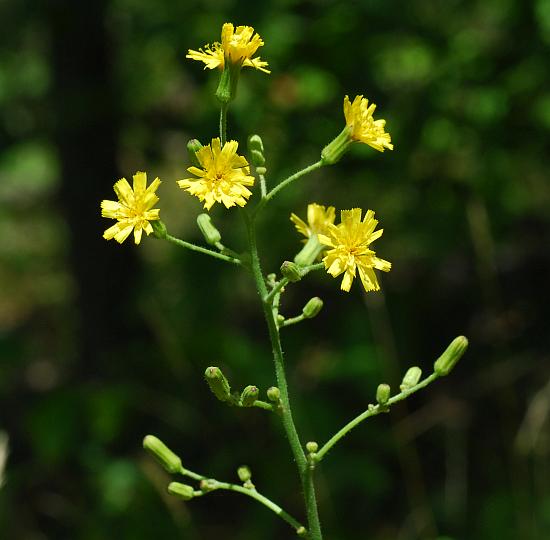Hieracium gronovii L.
Beaked Hawkweed

Native
CC = 4
CW = 5
MOC = 63
© SRTurner
Hieracium gronovii L.Beaked Hawkweed | |
 |
Native CC = 4 CW = 5 MOC = 63 |
© SRTurner |
|
Family - Asteraceae/Cichorieae Habit - Perennial forb with a short, usually erect or ascending rootstock, rarely with a short, spreading rhizome, with milky sap. Stems - Erect, mostly solitary, to 85 cm, moderately to densely pubescent, at least toward the base, with light orangish brown, spreading to loosely ascending hairs 4-9 mm long having a bulbous or slightly expanded base, these sometimes becoming sparse or nearly absent toward the tip, usually also inconspicuously pubescent with cobwebby, minute, branched hairs, often also with sparse, gland-tipped hairs toward the tip.
Leaves - Basal and alternate, simple, entire, sessile to short-petiolate. Basal leaves with the blade 3-20 cm long, narrowly oblanceolate to obovate, rounded to sharply pointed at the tip, the surfaces and margins pubescent with sparse to moderate, spreading, bulbous-based hairs and often also sparse to moderate, minute, inconspicuous, branched hairs. Stem leaves sometimes few and basally disposed, sometimes several and well spaced, similar to the basal leaves but gradually reduced in size, more often sessile, oblong-obovate to oblanceolate, the uppermost with the base often slightly clasping the stem.
Inflorescence - Elongate cylindrical panicles or racemes of flowering heads.
Heads - Ligulate. Involucre 6-9 mm long, the inner series of bracts narrowly oblong-lanceolate, pubescent with inconspicuous, cobwebby, branched hairs and sometimes also longer, spreading, usually dark-colored, gland-tipped hairs, the outer series much less than 1/2 as long as the inner series.
Flowers - Ligulate florets 20-40. Corollas 7-9 mm long, 5-6 toothed at apex, light yellow to yellow. Pappus bristles 4-5 mm long, light yellowish to orangish brown. Style yellow, bifurcate, 1 cm.
Fruits - Achenes 2.5-4.0 mmlong, narrowly ellipsoidal, somewhat tapered, beakless. Tips slightly but noticeably expanded. Pappus bristles typically brownish.
Flowering - May - October. Habitat - Upland forests, ledges and tops of bluffs, glade borders, pastures, fields, roadsides. Origin - Native to the U.S. Lookalikes - H. longipilum, H. scabrum; more broadly, many other species in the Cichorieae tribe, such as species of Crepis, Hypochaeris, and others. Other info. - This plant is distinctive and tough to miss in the wild. It is common across the southestern half of Missouri, and most of the southeastern quadrant of the continental U.S. Oddly, it is considered a noxious weed in West Virginia. The scabrous leaves and long cylindrical inflorescences of yellow ligulate heads make it easy to ID. The amount and type of pubescence can vary greatly, as can be seen in the stem photos above. The plant bleeds milky sap if injured. Photographs taken in Brown Summit, NC., 8-11-02 (DETenaglia); also at Cuivre River State Park, Lincoln County, MO, 8-16-2010, Greensfelder Park, near Pacific, St. Louis County, MO, 9-22-2012, and Young Conservation Area, Jefferson County, MO, 7-27-2013 (SRTurner). |